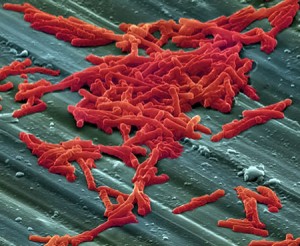Clostridium difficile or C-diff is a bacterium that 5-10% of the population have in their intestine as part of their normal flora, which is the intestinal composition of ‘good’ usually non-disease causing bacteria. In hospital settings, the amount of people that have C-diff in their intestine rises to 25%. C-diff is of particular concern in hospitals since there is a greater potential for patient to patient C-diff spread.
Some antibiotic treatments destroy the normal flora, however C-diff is a spore former, so it is not killed by many antibiotics. The absence of most of the normal flora allows for C-diff to germinate and grow – this produces toxins! These toxins damage the mucus lining of the colon, which results in ulcers and layers of debris that leads to frequent diarrhea. The disease, called pseudomembranous colitis, can be fatal but is treatable with the powerful and costly antibiotic, Vancomycin. Despite treatment, there is still a high relapse rate of 10-20%.
A news article from The Seattle Times published that American doctors, including Dr. Lawrence Brandt and Dr. Christina Surawicz, have transplanted feces from a healthy person to a sick patient’s colon to combat C-diff and repopulate normal flora. Rest assured, the donors of the stool transplant are close relatives of the sick patient. The doctors of the news article claimed to have so far met success with this unconventional treatment. However, fecal transplants are not widespread and Dr. Brandt even noted that methods among doctors are inconsistent.
Locally, the CBC published an article indicating that the BC Fraser Health Authority had initially barred fecal transplants due to lack of study. I feel that this is currently reasonable until a greater amount of clinical trials are published. Of the published small scale case studies, one in 2009 obtained a ~73% success rate with fecal transplants and later in 2010 another study posted 100% success. There is also a full clinical trial underway from the University Health Network in Toronto.
Dr. Jeanne Keegan-Henry speaks on fecal transplants:

In my opinion, one of the issues of fecal transplants is that most of the published research is within the last two years. The long term effects of introducing a different composition of bacteria and potentially other things into a sick patient are not known. If full clinical trials continue to be successful, an antibiotic free treatment for C-diff would not only ease costs for patients, but also slow the development of multi-antibiotic resistant superbugs.






